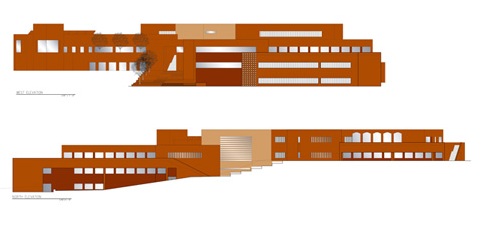

copyright 2007 by George Johnson
Davis Mansion, sunset, photo by George Johnson, copyright 2007
1. Retrofit Arithmetic (and Rainbarrel Economics)
2. The San Juan-Chama Shell Game
3. The Case of the Disappearing Aquifer
4. The Creative Hydrology of Suerte del Sur
5. The City, the County, and a Water Tax Revolt
6. Water Numerology at City Hall
(Our story thus far)
7. The Woman at Otowi Gauge
8. "Forget it, Jake. It's Chinatown."
9. The Las Campanas Connection
(Our story continues)
10. The Engineering Solution
March 31, 2007
40. Blinded by the Light
In a Robert Heinlein novella from the 1950s, space-traveling entrepreneurs scheme to sell Coca-Cola the right to paint its red and white logo across the face of the moon. I remember the story every evening as I shield my eyes from the glare of the picture windows on Andrew Davis's new hilltop mansion. No one really believed the assurances that this advertisement for himself would somehow blend in. Still it's a shock to see how utterly he has dominated the horizon. (Please see Chapters 15, Picking on the Davises, and 16, Tragedy of the Commoners.)
Early in the morning, it's the first thing to catch the sun.
So far (it's still early) Tom Ford is showing more class in his subjugation of the old reservoir hill, as he continues to replace, at considerable expense, the dozens of piñons killed by drought-crazed bark beetles. Here it is a year ago . . .
. . . and today.
Noblesse oblige. Mr. Ford's contractor, Doug McDowell, appears to be sincere in his efforts to buffer neighbors from the construction industry's equivalent of martial law. But there is only so much he can do. For the next year or more everyone for blocks around will be enduring the siege of construction trucks on the narrow unpaved streets. And then the limousines.
April 9, 2007
The Dempsey Papers
On January 25, 1930, in an act of astonishing short-sightedness, the City of Santa Fe gave 2,000 acres of prime public land -- the northwest corner of the original town grant -- to an oilman and real estate speculator named John J. Dempsey. In return, Mr. Dempsey, who would later become governor of New Mexico and a United States Representative, agreed to shoulder the burden of developing the property and (after deducting his expenses) split the proceeds with the city.
Looking back, it's hard to fathom what in the world our city fathers were thinking. Maybe their judgment was clouded by the recent stock market collapse, which set the stage for the Great Depression. Or maybe they had doubts about the city's ability to defend its ownership of the land. The Memorandum of Agreement (here is a photocopy of a photocopy) called for Mr. Dempsey to spend up to $750 for a lawsuit clearing the city's title and to pay $1,000 to settle a claim by the estate of A. B. Renehan. (Mr. Renehan was a prominent lawyer who owned a building on San Francisco Street and built one of the stately mansions on upper Palace Avenue.)
However he pulled it off, Mr. Dempsey and his heirs (represented now by an outfit called Santa Fe Estates) got quite a deal. Stretching west from Bishop's Lodge Road past St. Francis Drive and north to Tano Road, the land is now the site of The Lodge at Santa Fe (formerly the Radisson), Shadow Ridge Apartments, the Governor's Mansion, and the luxurious estates on Circle Drive, Camino Encantado, Brownell-Howland Road, and, of course, Governor Dempsey Drive.

On the other side of U.S. 84/285, the area includes Ricardo Legorreta's colorful Zocalo condominiums, the Las Estrellas subdivision, and the site on which Garrett Thornburg, come hell or high water, will build his enormous office complex.
Last week the proposal to help Mr. Thornburg with tax relief sailed through the Finance Committee without the slightest recognition that the Dempsey agreement poses a conflict of interest: At the same time the city is charged with impartially evaluating the project, it stands to get half the profits from the land sale.
In the rush to sign off on the plan, other questions have also been left hanging, like why a billion-dollar enterprise with no intention of leaving town needs government aid. Mr. Thornburg says he deserves the subsidy because of costly delays imposed by neighbors who dispute whether the village-like plaza described in the Vision Statement for the Northwest Quadrant, with a restaurant, food store, bakery, dry cleaners, and "financial services," can be construed to include a 100,000 square-foot office building with a parking lot the size of Albertson's at DeVargas Mall.
Mayor Coss, when he was a councilor, raised some of the sharpest objections at a hearing in 2004: "I just can't square what this Vision Statement says with what's proposed for this development." He was also dubious that Mr. Legorreta's imaginative design for the corporate headquarters complies with covenants in the original Dempsey agreement requiring something called "new-old Santa Fe Spanish or Indian Style" architecture.
But Mr. Thornburg like Mr. Dempsey is a very persuasive man. Mayor Coss has become one of his most enthusiastic supporters while the project marches forward with everyone treating it like a done deal. With full council approval still two months away, Mr. Thornburg has betrayed no doubts about the outcome. Ground breaking is scheduled for June.

April 12, 2007
Thornburg passed another hurdle last night, with the Council agreeing 5 to 2 with one abstention to put the matter to a final vote on May 30. Still no advice from our intrepid editorial writers on what to think about this issue. The decision is being made in a vacuum.

April 13, 2007
The New Mexican finally weighs in today on the Thornburg matter, and after some hemming and hawing buys the company's argument almost hook, line, and sinker -- even the part about its deserving the tax break as reimbursement for legal costs.
As in the past the editors dismiss the opposition -- neighbors have sued to enforce their interpretation of the Vision Statement -- as Nimbyism, overlooking the fact that a district court judge has ruled that the covenants are indeed legally binding. It's just that they are not enforceable until the property, which still belongs to Santa Fe Estates, changes hands and groundbreaking begins. Then, the court decrees, the challenge can proceed.
The question is, Against whom? In the revenue-bond shell game, Mr. Thornburg will close on a contract to buy the land from Santa Fe Estates and turn it over to a holding company called Ridgetop Road LLC, which will deed it to the city, which will lease it back to another Thornburg subsidiary . . .
Unless the lower court ruling is overturned on appeal -- the decision is still pending -- the city may find itself a partner to some costly litigation. One can only wonder whether that has been factored into the cost-benefit analysis of going into business with Thornburg Inc.
April 17, 2007
More on the Dying River Plan

The sorry state of the Santa Fe River has become national news with NPR's morning edition reporting on its distinction as America's most endangered stream. The designation is by a Washington-based organization called American Rivers, which describes the problem in uncompromising terms:
The major threat to the future of the Santa Fe River is the outdated assumption that a flowing river is a waste of water. . . . Santa Fe treats its river as an extension of the city's plumbing system that can be turned on and off (at the reservoirs) and as a dumping ground for polluted runoff in the lower reaches. . . .
The full report is on the group's website and is summarized by Staci Matlock in the New Mexican and John Arnold in the Journal.
There are, of course, much worse rivers. The purpose of the list is to showcase those for which there is hope. The efforts of the Santa Fe Watershed Association and Watershed West (Paige Grant is interviewed in the NPR piece) and Mayor's Coss's promises to revive the river are what put it on the map.
This comes after an encouraging story by Ms. Matlock on Sunday, Advocates push to revive S.F. river. Finally it seems the momentum is building.
"We see in the Santa Fe River a tremendous opportunity," American River's president, Rebecca Wodder, told the New Mexican. "It could be a model of how a desert city can keep a river flowing. Rivers are resilient. They can come back to life."

April 18, 2007
The naysaying about restoring the river has already begun with a surprisingly uninformed editorial in Journal North. (Maybe Karen Peterson is on vacation.) A little research would have informed the writer of some points made here before: that over time more water flows into the reservoirs than the city has the right to store. The minimal flow called for by the Watershed Association and other people who understand hydrology can be achieved with proper planning -- releasing water steadily in a small amount instead of in fitful surges when the dams are about to burst. The Journal also ignores the issue of aquifer recharge -- the water isn't lost; much of it trickles into the underground bank account. Even water that evaporates doesn't disappear -- it cools and dampens the air to the benefit of streamside vegetation,
For all that, the saddest part of the editorial is the attempt to drive a wedge into the heart of the city by pitting eastsiders against southsiders: if we can't restore the water all the way to the Rio Grande let's not do it at all. That's the spirit.

April 22, 2007
The Sunday Papers
The Journal's Kiera Hay has written an excellent article fleshing out the details of the Dempsey deal (described earlier on this page) and clearing up a point a lot of us have been wondering about: how much money has the city actually made from giving away the northwest corner of its land grant? The answer: $4.3 million through 2004, which averages out to about $58,000 a year. (No word on why the finance department is two years behind in its accounting.) In addition the city is currently getting $2.5 million in annual property taxes, but that would be happening no matter who developed the land.
In two pieces in the New Mexican, Jason Auslander, the paper's first-rate crime reporter, gives behind-the-scene details of the meltdown of the Santa Fe Police Department and the subsequent jump -- almost a doubling -- in residential burglaries. From the sound of it, an onging FBI investigation of the narcotics division (which involves a mysterious videotape of the police chief and his brother) has all but crippled a department that was already suffering from a severe shortage of officers.

on to Part 41, Invasion of the Spa People . . .
Coming pretty soon: The Battle for Talaya Hill
The Andrew and Sydney Davis Webcam
Santa Fe Review Detours of the Wild West
The Santa Fe Review

More links:
See the current flow of the Santa Fe River above McClure Reservoir with the USGS automated gauge.
The Otowi gauge shows the flow of the Rio Grande north of Santa Fe.
Santa Fe water information, a collection of documents and links